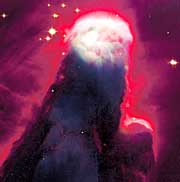Astronomers from NASA yesterday revealed images sent from the Hubble Space Telescope. The photographs show distant galaxies and galaxies colliding with each other. The photographs were taken by a camera that cost 75 million dollars, which was installed in Hubble about two months ago
Tamara Traubman

Astronomers from NASA yesterday revealed images sent from the Hubble Space Telescope. The photographs show distant galaxies and galaxies colliding with each other. The photographs were taken by a camera that cost 75 million dollars, which was installed in Hubble about two months ago. "These are the first astronomical images sent by the camera, they are breathtaking, and the camera, we now know, is performing excellently," said Dr. David LeCron, senior scientist in the space telescope project, at a press conference held by NASA yesterday. According to him, the new photographs "provide the sharpest and deepest glimpse into the depths of the universe that humanity has had so far".
One of the photos shows a "conical nebula", which looks like a column made of gas and dust. "The nebula that is relatively close to the Earth, at a distance of about 2,500 light years, in an area where many new stars are formed," said Lekron.
In another photo, two galaxies about 420 million light years from Earth are seen colliding with each other. According to Dr. Holland Ford, an astronomer from Johns Hopkins University and the chief scientist in the camera's development team, "what is most interesting is precisely the background of the photograph." In the background are seen about 6,000 galaxies in different stages of their development during the 13 billion years that have passed since the universe was created. The scientists assume that some of these galaxies were formed in the first billion years of the birth of the universe. "It is still not clear to us how at such an early stage there was such a relatively large number of galaxies," Ford said, "but I am sure that the camera will allow us to go deeper into earlier times and gather more clues."
****

A new camera, installed in March on the Hubble Space Telescope, began providing images of the most distant objects in the universe. This is what scientists claim, who published the first pictures yesterday. This camera is "a wider and clearer window," said Holland Ford, a professor of astronomy at Johns Hopkins University.
Ford is the senior member of the team of researchers who built the camera together. "With the help of this camera, we will reach the deepest view that the human eye has ever seen of the universe," he added.
The spectacular images, in which colliding galaxies and curling nebulae are seen, were each taken over the course of a day by the special camera called the Advanced Camera for Surveys. For comparison, producing images of distant galaxies by the previous camera installed in 1993 took 10 days.
The features of the advanced camera are useful for researchers - double the contrast and review range than was available until now, and the sensitivity is five times higher than that of the old camera.
Ford described the new images and the capabilities of the camera, as if it was receiving information from the "twilight zone". He added that researchers using this camera will be able to see as many stars and galaxies in the coming year as the number of objects that the "Hubble" has transported in its 12 years in space.
